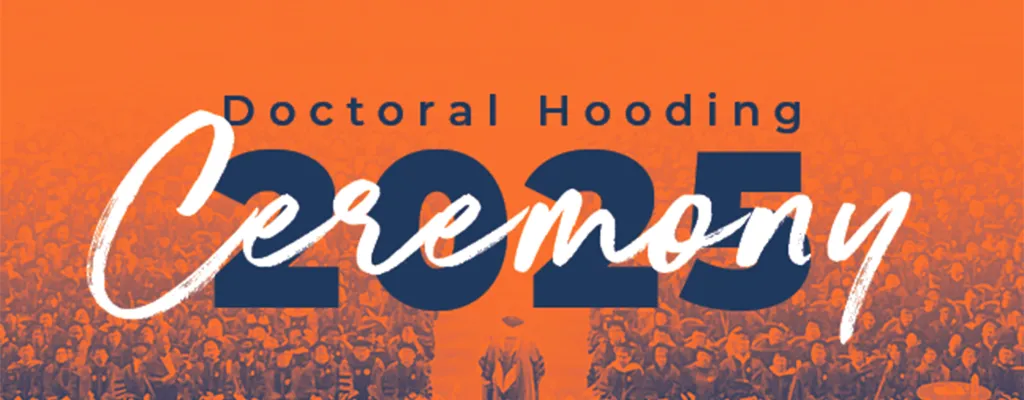Congratulations Graduates
Saturday, December 13 | 10:00 a.m. | Krannert Center for the Performing Arts
Welcome family and friends around the world!

A Welcome from the Dean

We are immensely proud to celebrate our graduates who have earned the highest degree, the doctorate, along with their faculty mentors.
Doctoral hooding is a symbolic gesture that represents the culmination of scholarly and personal achievement. During the ceremony, the hood is placed over a student’s head by a mentor or senior scholar, marking the transition from learner to producer or contributor in one’s field. It recognizes their academic achievements and welcomes them into the community of scholars.
Illinois has a rich tradition in doctoral education. Our first two Doctor of Philosophy degrees were awarded in 1903, one in Chemistry and one in Mathematics. That was over 100 years ago. The graduates celebrated this term join generations of distinguished alumni who are leaders and innovators, impacting the lives of people around the world. I am confident that these graduates, with their commitment and perseverance, will use their knowledge and expertise to shape our future in profound ways.
We are excited to celebrate all you have accomplished, surrounded by the family, friends, mentors, and colleagues who helped you succeed.
Sincerely,
Wojtek Chodzko-Zajko
Vice Provost for Graduate Education and Dean of the Graduate College
Order of Ceremony
Welcome
Wojtek Chodzko-Zajko, Vice Provost for Graduate Education and Dean of the Graduate College
Greetings from the Chancellor
Charles L. Isbell, Jr., Chancellor
Greetings from the Provost
John Coleman, Provost and Executive Vice Chancellor for Academic Affairs
Remarks from the Speaker
Nathan Schroeder, Associate Professor in the Department of Crop Sciences
Recognition of Graduates
Each graduate will be called individually and hooded by a member of the graduate faculty.
Graduates will be recognized by college in the following order:
- College of Agriculture, Consumer & Environmental Sciences
- College of Applied Health Sciences
- Gies College of Business
- College of Education
- Grainger College of Engineering
- College of Fine & Applied Arts
- School of Information Sciences
- School of Labor & Employment Relations
- College of Law
- College of Liberal Arts & Sciences
- College of Media
- School of Social Work
- College of Veterinary Medicine
About our Speaker

Dr. Nathan Schroeder is an associate professor in the Department of Crop Sciences at the University of Illinois Urbana-Champaign. He is also an affiliate of the Neuroscience and Ecology, Evolution, and Conservation graduate programs. Dr. Schroeder received his PhD from the University of Wisconsin-Madison and completed postdoctoral training at Rutgers University. His research focuses on microscopic worms called nematodes and spans both fundamental questions of cell structure and applied research focused on the control of parasitic nematodes.
Dr. Schroeder is a strong supporter of graduate education and the importance of mentoring in training the next generation of scientists. Dr. Schroeder has served on the Graduate College Executive Committee and was both the Director of Graduate Studies for the Department of Crop Sciences and the Associate Director of Student Success for the Neuroscience program. He is a member of the National Research Mentoring Network and was awarded the University of Illinois Campus Award for Excellence in Graduate Student Mentoring.
Ritual and Tradition of Academic Dress
History of Academic Dress
The history of academic dress begins around the twelfth century when the earliest universities were forming in Europe. At that time, the dress of a scholar—whether student or teacher—was that of a cleric. Typically, a medieval scholar would have taken ecclesiastical vows and would have been tonsured. The long gowns were worn primarily for warmth and hoods would have covered the heads of the scholars who spent many hours in unheated monasteries where ancient texts were maintained.
Subsequently, the material of the gown and lining, and the shape of the hood, represented the economic, social, and academic status of the wearer. The wearing of distinctive regalia for universities emerged in England in the second half of the fourteenth century.
In the United States, the tradition of academic dress dates to the 1880s, when different institutions established their own academic dress codes. Black is the traditional color for gowns, although at the University of Illinois at Urbana-Champaign, academic dress has been designed specifically for the Institution—blue gowns with orange accents and blue mortarboards
Features of Doctoral Regalia
Today the doctoral gown is faced down the front with velvet and has bell-shaped sleeves with three bars of velvet across each sleeve, differentiating it from the bachelor’s and master’s gowns. The facing and bars may be black or blue, as is the case at Illinois, or may be the color of the subject to which the degree pertains. Doctoral gowns may be worn open or closed.
Another distinction of the doctoral gown is its longer hood, which measures 4 feet. Hoods are lined with the official color or colors of the college or university conferring the degree. At Illinois, the lining is orange and blue.
The five-inch, colored, velvet border of the hood identifies different doctoral degrees as follows:
- Dark Blue – Doctor of Philosophy / PhD
- Light Blue – Doctor of Education / EdD
- Pink – Doctor of Musical Arts / DMA
- Purple – Doctor of the Science of Law / JSD
- Medium Blue – Doctor of Audiology / DAud
For Event Details
To find more information for participants, including registration, visit the Doctoral Hooding Registration and Participant Information page.
For information about December 2025 Commencement ceremonies visit the Commencement website.
